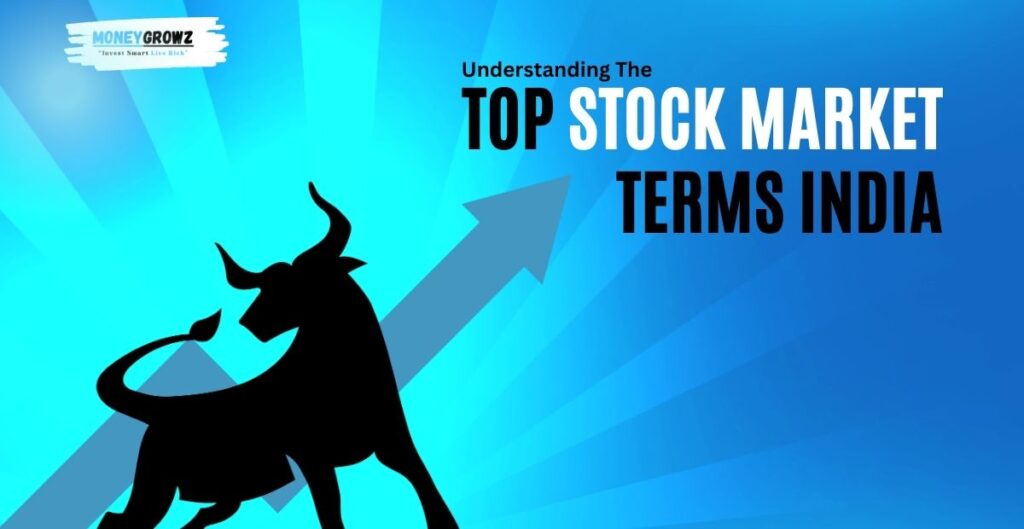Introduction
The
Indian stock market is an exciting avenue for wealth creation, but understanding the
key investment terms is crucial for making informed decisions. Whether you are a beginner looking to invest in stocks or a seasoned investor aiming to refine your knowledge, familiarizing yourself with stock market jargon can help you navigate the market with confidence.
This blog will break down
10 essential stock market terms every Indian investor should know. From stock indices like
Sensex and Nifty to valuation metrics like the
P/E Ratio, these terms will serve as a foundation for your investment journey.
1. Sensex & Nifty 50 – India’s Benchmark Indices
Stock market indices act as indicators of the overall market performance. In India, two major indices dominate the market:
- Sensex (BSE Index): The Bombay Stock Exchange (BSE) tracks the performance of the top 30 companies listed on the exchange. It is considered a benchmark for India’s stock market health.
-
- Nifty 50 (NSE Index): The National Stock Exchange (NSE) comprises the top 50 companies from different sectors, representing market trends.
Why It Matters?
Investors use these indices to measure market sentiment. If the
Sensex and Nifty are rising, it generally means that investors are optimistic. If they fall, it indicates market pessimism.
2. Bull Market & Bear Market – Market Trends Explained
Stock markets fluctuate, and investors classify market movements into two broad categories:
-
- Bull Market: A rising market where stock prices continuously increase, reflecting economic growth and investor confidence.
-
- Bear Market: A declining market where stock prices fall by 20% or more, signaling economic slowdown or investor fear.
Example:
The Indian stock market experienced a
bull market from 2016-2019, while the
COVID-19 crash in March 2020 led to a brief bear market.
3. IPO (Initial Public Offering) – Entering the Market
An
IPO is when a private company sells shares to the public for the first time, becoming a publicly traded company. Recent IPOs in India, such as
Zomato, Paytm, and Nykaa, have generated significant investor interest.
Why It Matters?
-
- IPOs offer investors a chance to buy stocks early before they get listed on the stock exchange.
-
- High-demand IPOs can lead to listing gains, while some IPOs may underperform.
- Tip: Always analyze a company’s fundamentals before investing in an IPO.
4. Market Capitalization – Measuring a Company’s Size
The total value of a company’s shares is referred to as its market capitalization, or market cap. Based on market cap, Indian companies are categorized into:
-
- Large Cap (₹50,000 Cr+): Reliance, TCS, HDFC Bank
-
- Mid Cap (₹10,000 – ₹50,000 Cr): Tata Elxsi, Voltas
-
- Small Cap (Below ₹10,000 Cr): Dixon Technologies, BSE Ltd
Why It Matters?
Large-cap stocks are stable but grow slowly, while small-cap stocks offer high growth potential but are riskier.
5. P/E Ratio (Price-to-Earnings Ratio) – Stock Valuation Tool
The
P/E Ratio is a key metric used to determine if a stock is
overvalued or undervalued.
Formula:
P/E=Stock PriceEarnings Per Share (EPS)P/E = frac{text{Stock Price}}{text{Earnings Per Share (EPS)}}
-
- High P/E (Above Industry Average): The stock is expensive, may indicate high growth expectations.
-
- Low P/E: The stock is undervalued or not growing fast.
Example:
If
TCS has a
P/E ratio of 30 and
Infosys has
P/E of 25, Infosys may be
cheaper compared to TCS based on earnings.
6. Dividend & Dividend Yield – Passive Income for Investors
Dividends are profits
distributed by companies to their shareholders. Some companies pay regular dividends, making them attractive for long-term investors.
Dividend Yield=Annual Dividend Per ShareStock Price×100text{Dividend Yield} = frac{text{Annual Dividend Per Share}}{text{Stock Price}} times 100
High Dividend Stocks in India:
-
- ITC, Hindustan Unilever, Infosys (Stable dividend-paying stocks)
- Tip: Dividend-paying stocks are great for passive income investors.
7. Circuit Limit – Protecting Market Volatility
The
circuit limit is a
price band set by SEBI to prevent excessive volatility.
-
- Upper Circuit: The highest price a stock can reach in a trading session.
-
- Lower Circuit: The lowest price a stock can fall in a session.
Example:
During
March 2020, the Indian stock market hit the
lower circuit due to the COVID-19 panic.
8. Stop Loss & Limit Order – Risk Management Tools
-
- Stop Loss: A tool that automatically sells a stock if it falls to a certain price, minimizing losses.
-
- Limit Order: An order to buy/sell a stock at a specific price rather than the current market price.
Why It Matters?
These tools help traders control risk and
avoid emotional investing.
9. FII & DII – Who Controls the Market?
-
- FII (Foreign Institutional Investors): Foreign entities investing in Indian markets (e.g., Morgan Stanley, BlackRock).
-
- DII (Domestic Institutional Investors): Indian financial institutions like LIC, mutual funds, and pension funds.
Impact on Market:
-
- FII Inflows = Market Boom
-
- FII Outflows = Market Correction
10. SEBI – The Watchdog of Indian Markets
The
Securities and Exchange Board of India (SEBI) regulates the stock market to ensure transparency and protect investors.
Key Functions:
-
- Prevents insider trading and market manipulation.
-
- Regulates mutual funds, IPOs, and stock exchanges.
-
- Protects retail investors from fraud.
- Tip: Always invest in SEBI-regulated financial products to avoid scams.
Final Thoughts
Understanding these
10 essential stock market terms can empower you to make smarter investment decisions in India. Whether you are a beginner or an experienced investor, keeping up with market fundamentals is the key to long-term wealth creation.
What other stock market terms would you like to learn about? Drop a comment below!
“Did you find this guide helpful? Which stock market term do you want to learn more about? Comment below, and we’ll cover it in our next blog!”



